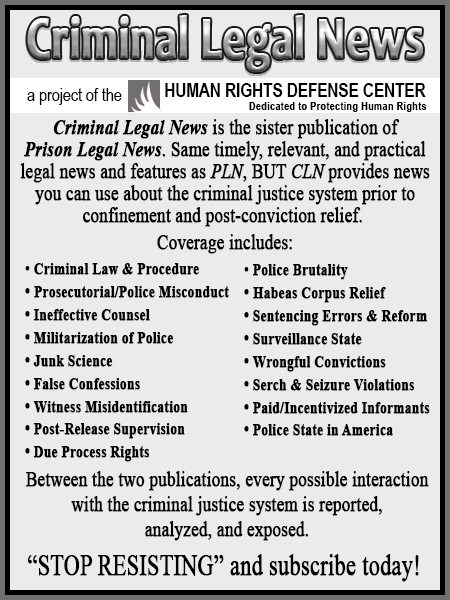When Your Criminal Case Is Dropped, But Your Mugshot Lives Forever
by Julie Levitch, The Crime Report
Just as protests spread across the country in response to the killing of George Floyd, I was arrested—a white, middle-class, suburban mom with no criminal record.
While the appalling circumstances surrounding my arrest and dismissal of my case didn’t make headline news, the event introduced me firsthand to the long-lasting harm caused by law enforcement agencies’ practice of publishing booking mugshots online.
As the country debates the path forward for criminal justice reform, much of the focus has been on addressing the critical issues of excessive force and mass incarceration. Meanwhile, the practice of running digital mugshot galleries of arrestees, maintained by police and sheriff’s offices, has largely flown under the radar.
With thousands of booking mugshots published each day online, there has been little discussion of the profoundly negative impact of a practice that harms a much larger swath of individuals and continues to exacerbate racial stereotypes.
According to the Brennan Center for Justice, there are approximately 70 million people in the United States who have a criminal record of some kind. For many of these individuals, having a mugshot plastered over the web can have a devastatingly punitive effect.
A single online mugshot, for even a minor non-violent misdemeanor, can become a barrier to getting a job, finding housing, or forming personal relationships, regardless of whether someone is ever convicted of a crime.
Pushback on publishing mugshots online has been spotty as legislators struggle to create laws that address the reality of today’s digital age.
With criminal justice reform still a national topic, there is a compelling need to challenge the legality of this practice and expose the law enforcement agencies that are flagrantly disregarding two fundamental principles of our criminal justice system: presumed innocence and due process.
A Phoenix Story
On a hot summer evening in 2020, I had driven to the home of my long-term boyfriend, Dan, to return his phone. He had left it at my house following a dinner I prepared. Because his doorbell was non-functional, I knocked on the front door.
When he didn’t respond, I knocked on the window adjacent to the door. Unbeknownst to me, the window had a hairline crack in it. And when I knocked, it broke. Startled by the shattered glass, my heart began to race—a symptom of supraventricular tachycardia, a chronic condition that I suffer from.
Hearing the glass break, Dan opened the door, and I immediately showed him what happened. We talked, and I handed him his phone. I mentioned that my heart was beating fast and was going home to rest.
As I walked back to my car, I fainted on Dan’s driveway—a symptom of my heart condition. Dan heard me fall and rushed to try and revive me.
Meanwhile, a neighbor, who heard glass break, called the police. When I regained consciousness, there was a Phoenix police officer shining a flashlight in my eyes and another officer handcuffing Dan.
In the police report, the officer noted “I observed Julie there with her eyes rolling back of her head.”
Flat on my back, with my heart beating irregularly and pain from the fall I had just taken, I struggled to speak. Yet, the police attempted to question me. I told them that I had broken a window by accident.
That propelled them to uncuff Dan. And I immediately became the suspect.
The paramedics called to the scene confirmed that I was experiencing heart rhythm irregularities. However, the officers refused to call an ambulance, despite my boyfriend’s pleas to do so.
Instead, I was arrested for Criminal Damage – Defacing Property. I was never read my Miranda Rights and too frightened to attempt to ask for a supervisor in that moment. I was silent as they handcuffed me and led me to their vehicle.
Dan stated to the officers that this was an accident and wouldn’t file charges. He even called a Phoenix Police supervisor to his home to lodge a complaint against the officers. He explained the wrongful assumptions of the police, but my arrest was already in process.
At the local police substation, I fainted again. The paramedics were called to the scene and confirmed that I was experiencing atrial fibrillation. This is detailed in the body cam footage which I later obtained.
As a law-obeying citizen, who had never had as much as a traffic ticket, the entire experience was dumbfounding and surreal. It seemed as if someone surely was going to step in and stop the chain of events. No one did.
Instead of being transported to the hospital for medical care, I was driven to the Maricopa County Jail where I was cavity searched, pregnancy tested, drug tested, fingerprinted repeatedly, and photographed.
Then, I was held in a solitary, white concrete cell in the Maricopa County jail for nearly 16 hours, unclear of what was happening next. Throughout this extended “booking process,” I struggled with my erratic heart rhythm. Because there was broken plumbing in my cell, I had no access to potable water to drink during this time.
After being assigned a hearing date by a judge who visited my cell, I was released on my own recognizance at 1 pm the next day.
After a preliminary hearing scheduled two months after my arrest, a prosecutor was assigned to my case, and a trial was set for December 24, 2020. Fortunately, Dan was able to intervene. As the so-called “victim,” he had the legal right to speak directly with the prosecutor. After explaining the facts of what happened, she promptly dropped the charge.
A Reputation Damaged
While my case was quickly dismissed, the nightmare was just beginning. I have suffered extensive, ongoing damage to my reputation. The Maricopa County Sheriff’s Office (MCSO) published my booking mugshot on their website, along with over one hundred other individuals who had been arrested that same day.
Within one day of my arrest, online entities scraped the data from the site and republished my mugshot, personal information and arrest details on websites indexed by Google and other search engines.
The photo was coupled with personal data, including my full name, height, weight, and birthdate. The MCSO website has no disclaimer stating the photos are of individuals who have not been convicted, nor that they’re presumed innocent until proven guilty.
The booking photo rose to the top of online search results for my name.
And then the daily barrage of spam emails began, flooding my personal email inbox with ominous subject lines like “Your Damaging Record,” “Reputation Threat Alert,” and “Someone Saw Your Criminal Record on Your Profile.”
One year later, I continue to be bombarded by emails and ads to purchase reputation management services to clear my name. In other words, I am being extorted. With swift and callous disregard, the Maricopa County Sheriff’s Office has damaged my reputation, spawning online harassment and embarrassment in perpetuity—all for an unwarranted arrest and a single, dropped misdemeanor charge.
A Lack of Standard Practice
The United States Marshals Service, the custodian of federal arrest records, has long prohibited the disclosure of federal mugshots, considering the practice to be an “unwarranted invasion of privacy.” However, this isn’t the case when it comes to state and local law enforcement.
Across the country, there is a patchwork of policies that police and sheriff’s offices have enacted when it comes to booking mugshots. Some responsibly strive to make arrest data public while also shielding the privacy of arrestees.
This can be accomplished in a number of ways, including utilizing an online search tool to look up a specific name or providing a downloadable PDF of arrest data. Meanwhile, others see no issue with promoting extensive rogue galleries of photos of every individual processed through their system.
One of the most egregious examples is South Carolina’s Spartanburg County Sheriff’s Office which includes mugshot images, as well as home addresses of all arrestees. In Maricopa County where I was arrested, the former sheriff, Joe Arpaio, gained considerable notoriety for encouraging website visitors to cast votes on mugshots.
The mugshot with the most votes was deemed the “Mugshot of the Day” and given special prominence on the website. While “Sheriff Joe” is no longer at the helm of the MCSO, the practice of shaming arrestees through the publishing of mugshots has remained—all under the watchful eye of his more liberal predecessor, Paul Penzone.
New Laws to Stop the Release of Booking Photos
In recent years, several states have considered legislation surrounding the publishing of booking mugshots. Florida, Delaware, and North Dakota have all introduced bills that would allow only photos to be released if a suspect is an “imminent threat” or a wanted fugitive. And Georgia, Oregon and Arizona have enacted legislation to prohibit commercial sites from charging fees for removing inaccurate mugshots upon request.
However, these laws do little to protect individuals from the broad-based, damaging impact of the photos published by law enforcement.
California Gov. Gavin Newsom recently signed into law AB 1475, which prohibits law enforcement agencies from posting mugshots on social media channels, such as Facebook and Instagram.
However, the law only applies to those charged with non-violent crimes. It also doesn’t prevent agencies from continuing to publish all mugshots on their own websites, nor does anything to stop third-party sites, such as reputation management providers, from using the data for commercial purposes.
Although Assemblyman Evan Low, who wrote AB1475, believes it will reduce implicit bias, the bill actually does very little to prevent innocent individuals from having their reputations smeared by law enforcement agencies.
Surprisingly, the one standout in mugshot-related laws is the State of Utah. In February, Utah Senate unanimously voted in favor of HB 228 to ban police from releasing mugshots until a person has been convicted of a crime.
The bill, proposed by GOP Representative Keven Stratton, said his bill “seeks to address the inequality” in “today’s high- tech world when a mugshot is released based on arrest or accusation” causing a person to have “a virtual scarlet letter.” The bill garnered bipartisan support, including backing from both the conservative Utah County Attorney David Leavitt and Lex Scott, the leader of Black Lives Matter Utah.
The most vocal opponents of legislation restricting the publishing of mugshots continue to be the media which frequently uses arrest photos as part of news stories. However, a growing number of news outlets, including the Houston Chronicle, San Francisco Chronicle, and the Sacramento Bee, have ceased publishing booking mugshots.
According to the Bee’s assistant managing editor, Ryan Lillis, “We just felt like running photos feeds into stereotypes of who is committing crimes and undermines the argument of ‘innocent until proven guilty.’”
Suing the Maricopa County Sheriff’s Office
After contemplating what I should do about my own online mugshot and the damage done to my reputation, I decided to file a lawsuit against the Maricopa County Sheriff’s Office for a variety of constitutional violations, including my due process rights, defamation, false light, and invasion of privacy.
I’m prepared for a long process, but I am confident that my case will expose this damaging and unconstitutional practice for what it is and bring much-needed change to the law.
And if I can help prevent others from experiencing the pain and hardship of having a mugshot published online, I will feel that this experience has been a victory.
Julie Levitch is a technology writer and marketer who has been published in many national publications. She can be reached at julie@sourdoughcontent.com. This story was originally published at TheCrimeReport.org, November 3, 2021.
As a digital subscriber to Criminal Legal News, you can access full text and downloads for this and other premium content.
Already a subscriber? Login





